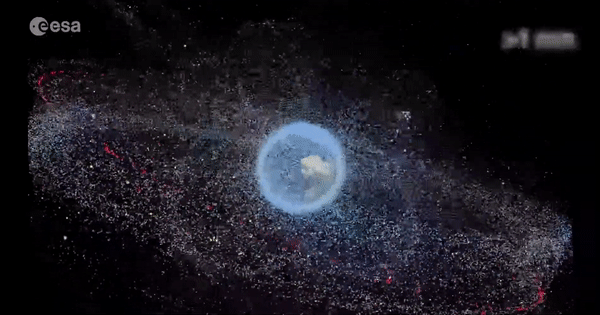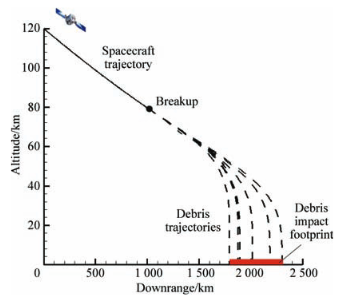The Art of Demise
General Overview of the Research Work
On an average, over the past decade, a space object above 800 kg has been re-entering every week, e.g. ESA’s GOCE in 2013, NASA’s UARS in 2011, and Chinese Tiangong-1 in 2018. Most of these objects do not totally demise during the atmospheric re-entry. Fragments may survive and reach the ground where they pose a risk to people and things. Space agencies are currently enforcing constraints on the casualty risk for the re-entry event and different re-entry analysis tools have been developed by agencies, industries and research centres to assess this risk. At the same time, new approaches to the design of spacecraft, aimed at increasing the probability of complete demise during re-entry, offer an effective way to meet these constraints. Thus re-entry analyses approaches have to be embedded into the design process since the very beginning, to evaluate the demise probability and casualty risk of different configurations. Currently, most of the efforts are focused on structural design for demise techniques, the improvement of high fidelity and low fidelity models used to predict the aero-thermal performance and thermo-mechanical response of objects, the implementation of efficient uncertainty quantification techniques for a more correct characterisation of the risks, and better understanding and modelling of material properties. Moreover, since demisability competes against the survivability of the object during its mission lifetime, design for demise can be seen as a multi-criteria and multidisciplinary design problem.
This research work will focus on the combination of computational intelligence techniques with rigorous mathematical modelling for the treatment of design problems affected by uncertainties to support Planetary Defence. The major focus is in the development and implementation of uncertainty based multi-fidelity and multidisciplinary approaches for the effective and efficient prediction of re-entry demisability and in-orbit survivability performance. Multi-fidelity methods will include high-fidelity approaches (e.g. DSMC or CFD for the aerothermodynamic part) as well as the formulation and implementation of low-fidelity methods capable to provide an optimal trade-off between computational complexity and level of accuracy and consistency with the physics. Multi-disciplinary refers to the necessity to account for various concurrent physical processes (e.g. aerodynamics, thermal, structural, 6-dof body dynamics, etc.).
Introduction
In a broad spectrum, the final problem associated with the space flight, interplanetary travel or satellite orbit is the survivability of the vehicle on the Earth/planetary surface or its complete demisability in the atmosphere. Space-mission planning for re-entry, begins with a set of requirements we must meet to achieve mission objectives. These requirements are completely opposite for demise and survivability of the mission. In the cases where survivability is important, the problem involves essentially deceleration of the vehicle, aerodynamic heating and control of the time and location of landing [1]. In cases where demisability is important, the problem involves controlling the spread of fragments, more flow exposure to surfaces, increasing the heat loads on the object, and overall reduction of the casualty area.
Much of the knowledge on the re-entry phenomena was developed in 1950s and was majorly focused on the design of re-entry vehicles which survive the re-entry trajectory. Since our main research focus is on space debris, we are looking for ways to completely demise the objects during the re-entry process. Though the design ideas clash from the much available re-entry knowledge, it is very important to have an overview of the fundamental concepts to adapt and improve our designs based on both survivability and demisability. Re-entry in a nutshell gives a very basic understanding of the underlying physical and chemical phenomena during an atmospheric re-entry.

The current data on near earth objects in space shows that there are almost 130 million debris objects (Source: ESA) in space, ranging from just a few mm in size up to many metre. Fig.2 shows the distribution of space debris around the Earth, we have 5400 objects which are >1 m, 34000 objects which are >10 cm, 900000 objects which are >1 cm, and 130 million objects which are >1 mm. Also, today we have nearly 2000 live satellites in space and more than 3000 failed ones (Source: ESA Clean Space). Furthermore, the space debris may collide with failed and non-functioning satellites and increase the number of debris exponentially. These events may result in an unreasonable number of debris entering the Earth’s atmosphere and we fear that these debris may survive the atmosphere, causing serious on-ground risk. There is a need for updating our design methodologies to ensure complete demisability of any component of satellites that may pose significant risk. The design ideas based on survivability conflict with the new space policies because of the casualty risk associated to ground population or infrastructure. Therefore, a lot of focus is on improving these ideas and inventing new concepts of design for demise.
The main tasks of the current research work are,
- Investigation of the state of the art low and high fidelity modeling for demisability and survivability prediction.
- Investigation of novel techniques for aero-thermal and thermo-structural analysis.
- Investigation and testing of multi-fidelity approaches for the effective and efficient assessment of demisability and survivability of complex objects, where complexity is due to shape, as well as different materials used.
- Integration of uncertainties on performances, models and operational conditions to have a probabilistic or evidence based assessment of demisability and survivability.
- Testing of the implemented system on reference cases and comparison with the results obtained by the state of the art methods and tools.
ESA Standards and Risk Assessment
Launch vehicle orbital stages and non-functional spacecraft at the end of mission or because of accidental failures, as well as mission-related objects, contribute to the space debris population. Furthermore, any launch vehicle orbital stage or spacecraft can be involved in fragmentation events due to orbital collisions and break-ups. The resulting fragmentation debris pose a significant risk for short and long-term survivability of any other operational space mission, since a spacecraft or launch vehicle orbital stage can have a high probability of collision if it passes through a region of high debris density concentration. This high debris density concentration can occur after a break-up event creating a debris cloud which also exhibits large spatial and temporal changes in the concentration of the spatial density in space.
According to ESA DISCOS database, 240 break-up events of spacecraft and rocket bodies were recorded up to May 2014: 74 (30.8%) due to propulsion system; 8 (3.33%) due to battery; 11 (4.58%) due to collisions (which includes potential collisions with sub-catalogued objects); 86 (35.8%) due to unidentified causes; 61 (25.4%) deliberate break-ups (source).
Re-entering space debris also may represent a hazard to human population, air and naval traffic, and ground and sea assets. Currently every year a few hundred of catalogued objects, including spacecraft, launch vehicle orbital stages, and fragments re-enter the Earth atmosphere without any control. A few tens of these objects are large and heavy enough to survive an atmospheric re-entry. Typically about 10-40% of the mass can survive (depending on the object design, re-entry trajectory, atmospheric conditions) and parts or fragments can reach the Earth surface with high kinetic energy. Propellant tanks, high-pressure vessels, and motor cases made of Titanium or heavy components like reaction wheels are often likely to reach the ground.
ESA’s techniques for space debris mitigation are used a priori to launch, during the design phases, to determine the potential risk caused to civilian and on-ground infrastructure. The document below explains the calculation of risk and related process.
General phases of re-entry trajectory

After reaching a re-entry interface (usually 120 km), the re-entry vehicle encounters a hypersonic, free-molecular flow. The aerodynamic forces are limited, and the object orientation remains stable (approx. 120 km - 90 km). The characteristics of air flow at hypersonic speeds have a deceptive simplicity. The object now enters into a pre-breakup phase (approx. 90 km - break-up altitude), the atmospheric effects become more dominant and the object starts tumbling and is heated by convective, reactive and radiative heat flux. At some point in the trajectory the object will certainly break up. Optical observations of the Columbia space shuttle, ATV reentries or the MIR space station reentry suggest that the object fragmentation is not a single catastrophic event but a sequential breakup cascade. After the sequence of breakups, the fragments originating from the initial object keep falling back to Earth. After this break-up point, no further breakup is expected, but each fragment is slowed down and ablated depending on its shape and material composition. Some of the fragments completely disintegrate while some of them survive and reach the ground. Around 20 km, the surviving fragments experience a free fall at subsonic velocity depending on their aerodynamic properties. Depending on the impact locations of the fragments, the expected number of victims and the probability of having a casualty can be computed.
Numerical Methods for Re-entry Flow Simulations
Throughout the re-entry trajectory, an object or a vehicle experiences several complex physical phenomena. The complex nature of the phenomena can be due to a change in the local density of atmosphere or due to very high speeds of the object/vehicle. An accurate analysis of the re-entry flows is highly multi-disciplinary and requires knowledge on aerodynamics, thermodynamics, high-temperature chemical reactions and fracture mechanics.
In a more general sense, the present research work concerns the aspects of aerodynamics, gas-surface interactions, structural thermomechanical response, and object fragmentation. A brief introduction of the above disciplines are discussed below.
- Flow regimes and hypersonic phenomena
- High-fidelity modeling and simulation
- Low-fidelity modeling and simulation
- Multi-fidelity modeling and simulation
Re-entry Tools and Modeling
Uncertainty Quantification and Propagation
The destructive re-entry of satellites and rockets and the related ground risk due to the fragments reaching the ground are getting increased interest in recent years (as discussed in the above paragraphs). Survived fragments derived from the launch vehicle’s ascent and the spacecraft’s reentry have been found and retrieved in many places all over the world. Fatal accident due to artificial space debris has not happened yet, however, survived fragments have been found at the place near populated areas. There is a strong need to accurately predict the risk quantitatively, and minimize the risk by the detailed consideration on the design and the disposal operations.
One of the main focus of the research study in WP2 lies in the accurate uncertainty quantification (reduction) of the destructive re-entry risk analysis. The uncertainty quantification factors and related research topics are identified, and effective uncertainty quantification strategies based on the high and low-fidelity numerical simulations are discussed.
To predict the ground risk due to the survived fragments, the multidisciplinary physics should be considered to describe the complicated destruction process. After a re-entry into the atmosphere, the spacecraft (or an object) experiences severe aerodynamic and aero-thermal loads. Those loads rapidly increase as the altitude decreases (due to the increasing atmospheric density). Finally, the spacecraft is broken into numerous fragments due to the thermo-mechanical fragmentation process. Most of the fragments are demised, but some can survive and reach the ground. Therefore, it is essential to predict the probability of the fragment survivability and the consequences based on quantitative physics-based models. The uncertainty in the current research problem is mainly dominated by the following factors (in-general):
- Multi-disciplinary nature of the related physical phenomena
- Prediction of initial conditions at re-entry
- The effect of the complicated shape, deformation and fragmentation
Uncertainty quantification is a huge research topic in itself and hence, a separate wiki page is dedicated to this topic for a detailed discussion.
Techniques for Uncertainty Quantification and Propagation